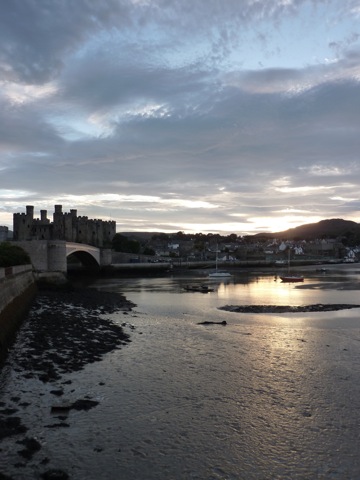
After Cardiff, my next base of operations was to be Conwy (above), a small town on the north coast of Wales. But getting from south Wales to north Wales by rail is surprisingly difficult: there's no mainline route which doesn't spend most of its time in England, and I wanted to see some of the Welsh countryside rolling past my window! Luckily, Chris suggested a workable alternative: take a main line train to Porthmadog, take a tourist steam train from there to Blaenau Ffestiniog, and from there another mainline train to Conwy (or rather Llandudno Junction, which is walking distance from Conwy). This would take all day, but since I probably would have done one of the tourist trains anyway, I didn't lose much in the way of holidaying time. And the rail trip was worth it!

That said, there was nothing really worth photographing for the first leg of the trip, from Cardiff to Shrewsbury (which is just across the border). Nor for most of the second leg, from Shrewsbury to Porthmadog, until I reached the coast at Harlech, with its famous 13th century castle. We may credit Edward I with remarkable foresight for placing it where it could best dominate the railway station when it was eventually built, nearly six hundred years later.
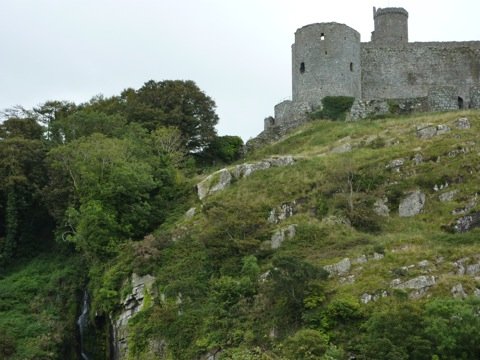
My train had the misfortune of connecting at Harlech with a number of school buses, which meant we had to wait for about half an hour before they all arrived. This did at least mean I could go outside and get some decent photos. It was also my first proper encounter with the Welsh language. In the south it's mainly only used on signs, as far as I could tell, but unless I'm more out of touch with the youth of today than I thought, every other conversation held between the schoolkids seemed to be in Welsh. Which turned out to set the pattern for the rest of my stay in Wales. It was nice to see that it is actually a living language, as opposed to something just learned in school.

On to Porthmadog Station. Actually, Porthmadog Harbour Station, because Porthmadog needs three railway stations -- the main line station I arrived at, the Welsh Highland Railway terminus next to it, and the Ffestiniog Railway terminus on the other side of town, to which I had to drag my luggage. Luckily there was plenty of room on the train for it all.

My loco for the day was Taliesin, which was rebuilt and brought back into service in 1999 (that's the decade before last, now).
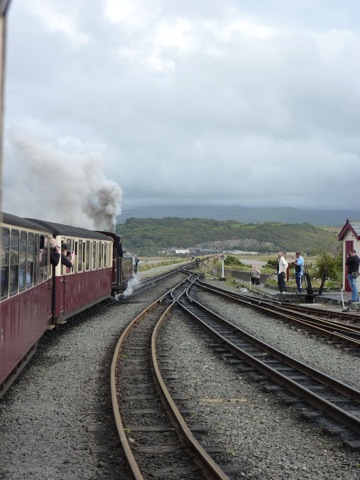
And we're off.
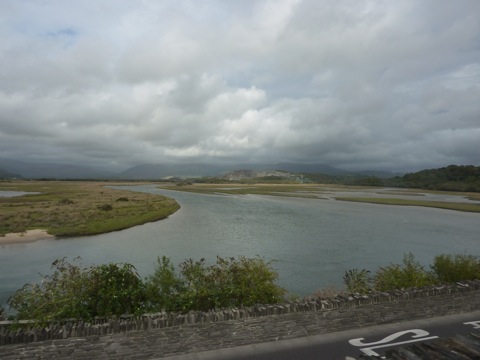
Porthmadog is close enough to the sea to be a viable port, and up until 1914 it was used to export slate (116,000 tons in 1873). Which is why the Ffestiniog Railway was built, back in 1836. It's the oldest railway company in the world.

At Minfford, we passed another train coming down. Leaning out the window to take a picture of it probably wasn't the brightest idea, but on this occasion I got away with it.
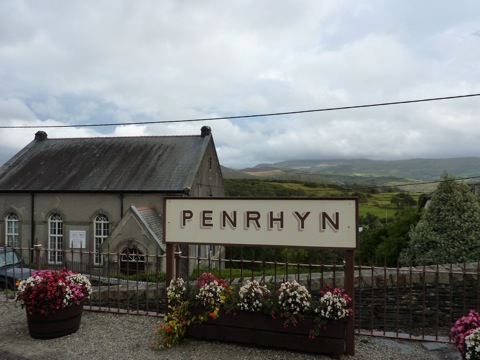
Penrhyn station (which is in Penrhyndeudraeth, but they evidently didn't make the signs long enough for that).

That's Snowdonia in the distance, or part of it ...
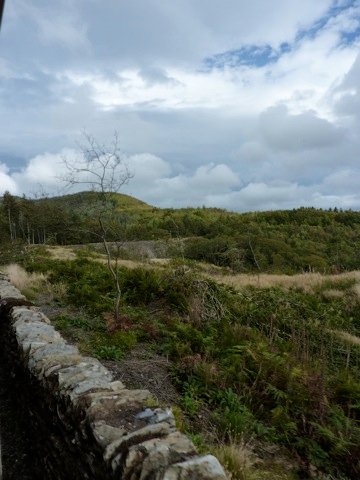
... which we were climbing into.

It's nice and wild-looking, though how wild any part of the British Isles can be said to be is open to question. (Actually, scratch that: I've seen York on a Saturday night.)

Taking on water at Tanybwlch. Climbing is thirsty work.

That sheep took no notice of the passing train at all.
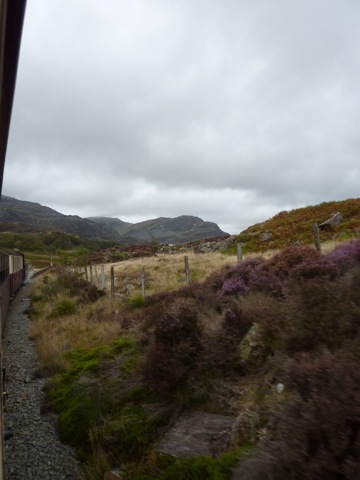
The higher we went the gloomier it got.
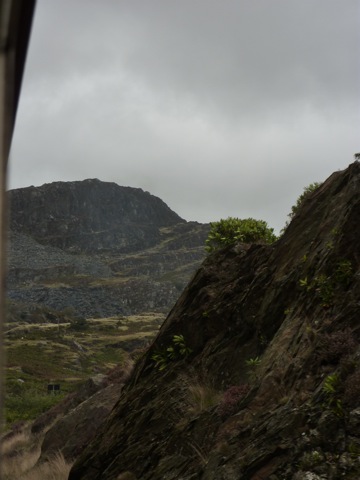
Gloomy and forbidding.
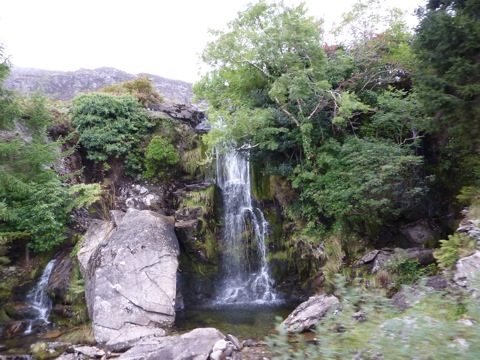
Gloomy, forbidding, and sometimes pleasantly green.
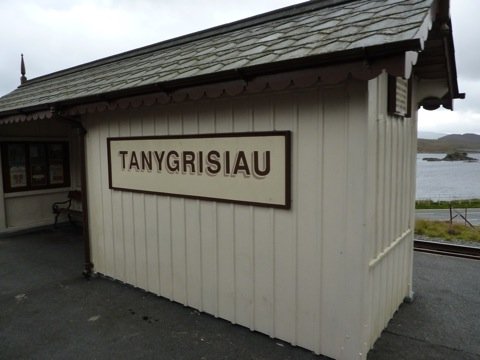
Come on, surely that's not a word, not even in Welsh!

I'm no geologist, but this is starting to look like slate country.
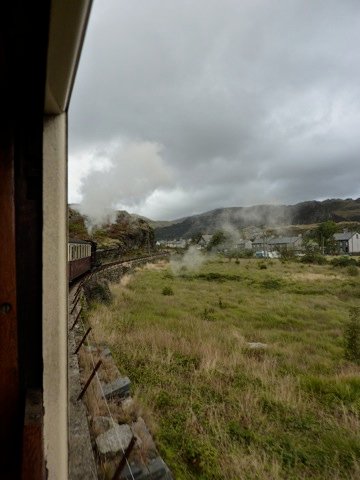
Coming into our final destination.

Blaenau Ffestiniog and Blaenau Ffestiniog station, in the middle of Snowdonia National Park. There are, or were, slate mines all around, hence the railway down to Porthmadog. The First World War ended the exports to Germany; the railway struggled on until 1946. Rail enthusiasts worked hard to get permission and funds to reopen the line for tourists, the first parts from the mid-1950s, the last link to Blaenau Ffestiniog in 1982. Thank you, train anoraks!

If Edward I had been on this trip, he'd be eyeing off that crag as the site for his next castle.

A last look at Taliesin as it gets ready for its last trip down for the day.
Blaenau Ffestiniog doubles as a mainline station, and it wasn't far now to Llandudno Junction.
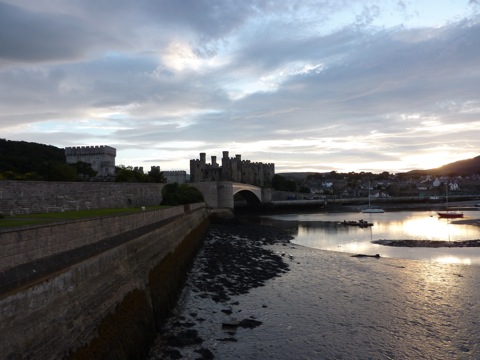
The timing was exquisite: by the time I got to the bridge across the Conwy, it was dusk.
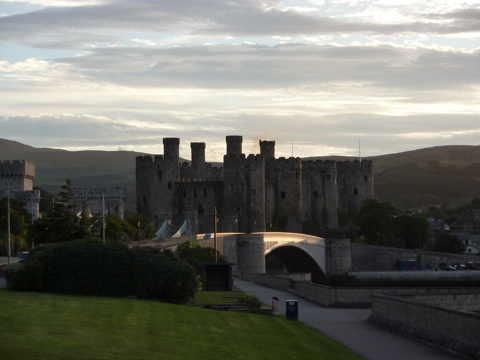
The castle certainly caught my eye.

As did the marina and -- look! town walls!
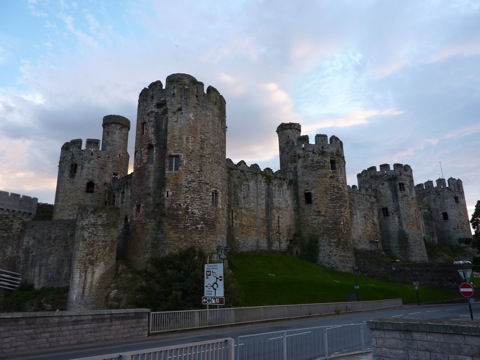
The route to my hotel took me under the walls of the castle. Of which, more next time.
![]() This work is licensed under a Creative Commons Attribution-NonCommercial-NoDerivatives 4.0 International License.
Permissions beyond the scope of this license may be available at http://airminded.org/copyright/.
This work is licensed under a Creative Commons Attribution-NonCommercial-NoDerivatives 4.0 International License.
Permissions beyond the scope of this license may be available at http://airminded.org/copyright/.


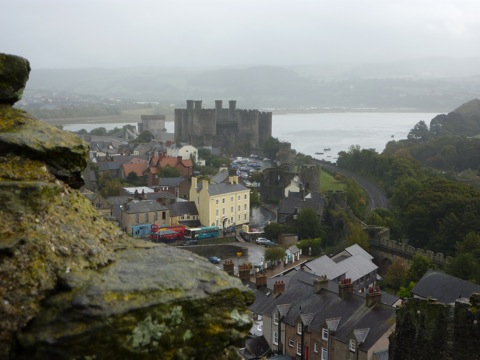
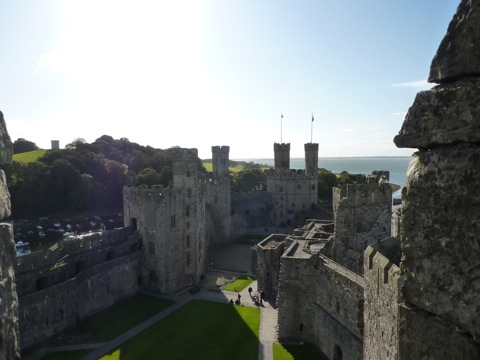
Gavin
You must have gone dangerously close to Portmeirion, but I guess Rover didn't get you.
Be seeing you...
Brett Holman
Post authorYes, I make a habit of fleeing giant floating beach balls!
Chris Williams
It's a pity that the Ffestiniog doesn't run past, or even through, Portmerion - that would be well Emett.
Emett. We've largely forgotten him now, but I think that Emett - famous between 1945 and 1960 - is an archetypical anti-airmined cultural phenomenon - a Wienerite reaction to the years of aluminium and Merlins, and an attempt to begin to look at technology as cute. His styles implied a return to cute tech, but I wonder if it wasn't actually an original thing: when had tech been cute in the UK? Perhaps we can blame him for declinism...
JDK
Ah, Emett, yes, his Welsh railway would run through Portmerion.
I wouldn't call him 'cute' though, more 'slightly disturbed'.
There's a slightly nightmarish quality to his drawings, more Lewis Carol than the relentlessly anti-technology Hardy, but something not present in the more famous W Heath Robinson's work - even WHR's war drawings were remarkably 'friendly'.
Note that both WHR and Emett were great 're-users' of simple mechanisms for complex purposes, part of the whimsy of their ideas, and a retreat to the comprehensible technology in the face of the frightening new nuclear world. However, both WHR and Emett had an implicit edge of catastrophe in their drawings, and interest in their work was the expectation that they *should* fail but... It's ironic that Emett had a retro-low tech centrepiece in the Festival of Britain in the heavilly bombed London. What conclusions can you draw from such a popular item in the middle of what was intended to be a celebration of British success and intent for the future? A retreat from complex reality to kettle-powered railways?
Thanks to Chris for a reminder of one of the great tinkerers Stuff here:
http://www.mech.mcmaster.ca/~nyet/emett/
Brett Holman
Post author'Cute tech' -- that phrase suggests to me a parallel with steampunk and other forms of nostalgia for retro technologies, some of which never even existed. It's valuing technology not for what it can do for you but what it means to you. It's a reaction against utilitarianism. As was the aesthetic movement (in another direction) -- maybe it's no coincidence that Heath Robinson was born in the same year as Aubrey Beardsley.
Nicholas Waller
One of the drivers behind steampunk and similar, I imagine, is a hankering for a time when bits of technology were big enough that you could see what they did - this connects to that and turns this, and so on; mechanical links instead of fly-by-wire. Nowadays we have a lot of sealed little black boxes with visually incomprehensible softmagic going on inside them. Hold a piece of movie film up to the light, and you can see all the little pictures; hold a DVD or mp4 file up to the light - and nothing.
As for Conwy, over the last few years I've been to Dwygyfylchi a few times, round the corner along the coast but within walking distance (over the hills) from Conwy. It's a good area for tackling Snowdon and Tryfan and suchlike. There's a fair amount of air activity, mainly trainee fighter pilots from RAF Valley blatting through the valleys.
Brett Holman
Post authorYes, I think that's a fair point regarding steampunk. OTOH, steampunk seems to have itself turned into an aesthetic movement -- a teak computer case with brass fittings and a few cogs on the side doesn't 'work' any differently to a normal beige case. And I wonder how many steampunks know how a steam engine works? :)
Chris Williams
I crave a desktop steam dynamo which will allow me to run my computer on meths. I know it's already running on steam (indeed, from some nearby vantage points I can see the very steam) but that's not so much fun.
Nikkki Copleston
Your trip has really inspired me! Having stumbled on your site almost by accident...!!
Brett Holman
Post authorI hope you make the trip yourself! It's well worth it, hopefully I'll be going back one day...